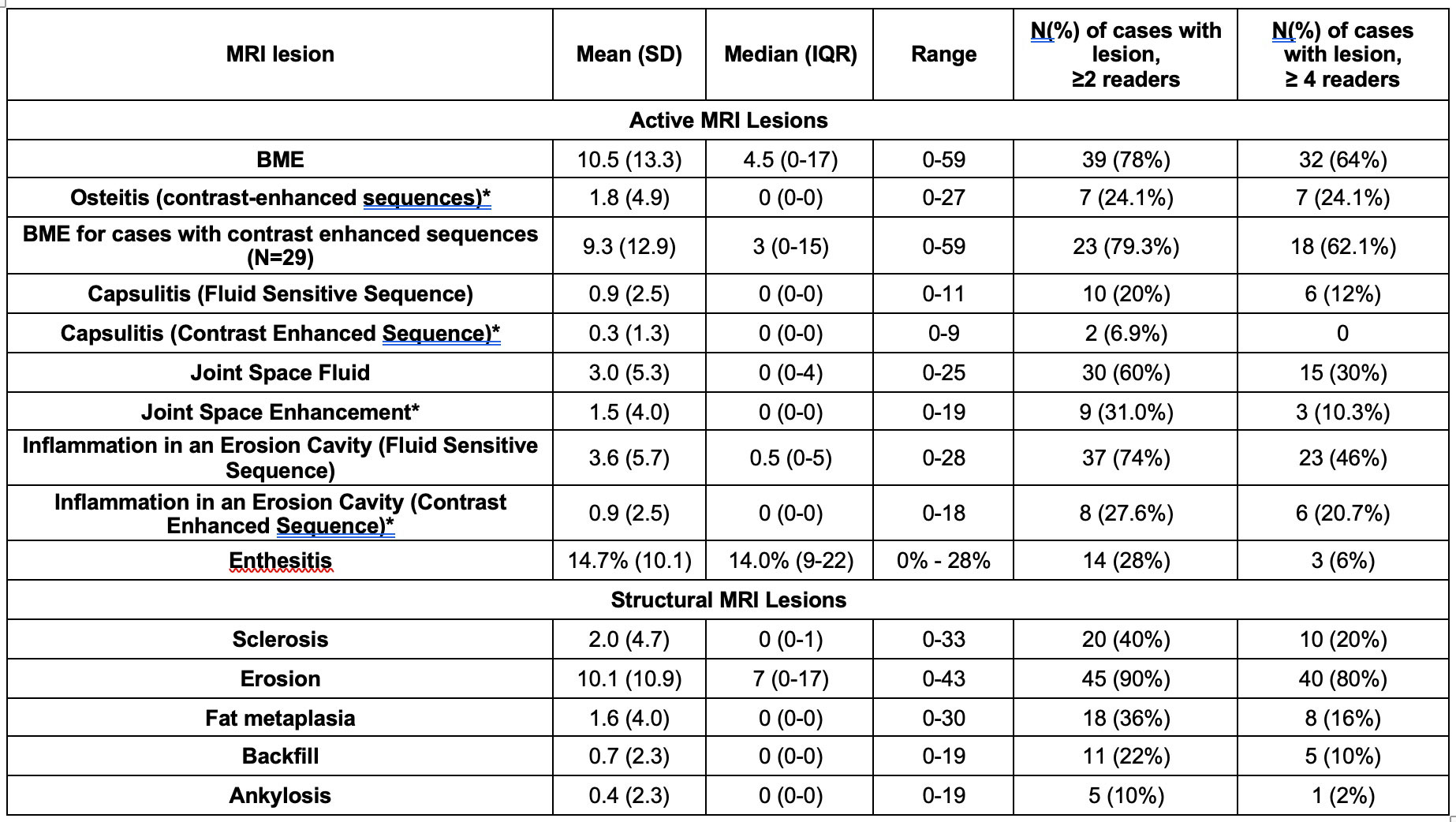Session Information
Session Type: Poster Session B
Session Time: 9:00AM-10:30AM
Background/Purpose: The evaluation of the sacroiliac joints (SIJ) in children with Juvenile Idiopathic Arthritis (JIA) increasingly relies on the use of MRI since radiography is unreliable and insensitive to change. This is particularly germane to clinical trials which require objective measures of inflammation and structural damage that are responsive within the placebo-controlled portion of the trial and enable discrimination between active therapy and placebo. The OMERACT JAMRI working group has defined a spectrum of MRI lesions in the SIJ that can be included in a scoring method intended for application in clinical research and trials. We aimed to assess the reliability of their detection and the impact of systematic calibration before deciding which lesions should be retained for the final scoring method.
Methods: MRI scans from a retrospective cohort of 50 children who had a rheumatologist JSpA diagnosis and had MRI for diagnostic evaluation of axial disease. To enable SIJ quadrant-based scoring according to rules developed by the Spondyloarthritis Research Consortium of Canada (SPARCC), all MRIs included semi-coronal slices through the cartilaginous part of the joint using fluid sensitive and T1-weighted sequences and 29 additionally included contrast-enhanced scans. MRIs were reviewed by 6 readers (4 MSK radiologists, 1 adult and 1 pediatric rheumatologist). MRI evaluation of the SIJ was based on standardized lesion definitions that represented a mix of definitions from ASAS and the OMERACT JAMRI working group. Prior to the scoring exercise, readers scored MRI scans from the SPARCCRETIC SIJ inflammation and structural damage calibration modules comprised of 50 DICOM axSpA cases with baseline and follow up scans on an online scoring interface. Continuous visual real-time feedback regarding concordance/discordance of scoring per SIJ quadrant with SPARCC MRI expert readers is provided by a color-coding scheme. Reliability is assessed in real-time by intra-class correlation coefficient (ICC), and cases are scored until pre-specified proficiency targets for ICC are attained.
Results: All readers achieved proficiency targets for scoring BME and fat lesions using the SPARCCRETIC calibration modules but only 3 attained proficiency for all structural lesions. BME was detected most frequently, especially on fluid sensitive as compared to contrast-enhanced sequences (Table 1). Capsulitis and inflammation in an erosion cavity were also detected more frequently on fluid-sensitive versus contrast-enhanced sequences. Erosion was the most frequent structural lesion, while fat lesion, backfill, and ankylosis were reported in < 20% of cases by majority read. Very good reliability was evident for BME, was superior to detection of osteitis, and did not change with calibration (Table 2). Calibration was effective in enhancing the reliability of detection of complex structural lesions such as erosions, backfill, and inflammation in an erosion cavity (Table 3).
Conclusion: Inflammatory lesions on MRI are detected more frequently and more reliably on fluid-sensitive than contrast-enhanced sequences. Systematic calibration can enhance reliability for detecting complex structural lesions such as erosion and backfill.
To cite this abstract in AMA style:
Maksymowych W, Varma N, Meyers A, Stimec J, Tzaribachev N, Akikusa J, Otobo T, von Rossum M, Doria A, Herregods N. Reliability of MRI Lesions Comprising the Preliminary OMERACT Juvenile Idiopathic Arthritis MRI Score (OMERACT JAMRI-SIJ): What Is the Impact of Systematic Reader Calibration? [abstract]. Arthritis Rheumatol. 2022; 74 (suppl 9). https://acrabstracts.org/abstract/reliability-of-mri-lesions-comprising-the-preliminary-omeract-juvenile-idiopathic-arthritis-mri-score-omeract-jamri-sij-what-is-the-impact-of-systematic-reader-calibration/. Accessed .« Back to ACR Convergence 2022
ACR Meeting Abstracts - https://acrabstracts.org/abstract/reliability-of-mri-lesions-comprising-the-preliminary-omeract-juvenile-idiopathic-arthritis-mri-score-omeract-jamri-sij-what-is-the-impact-of-systematic-reader-calibration/



